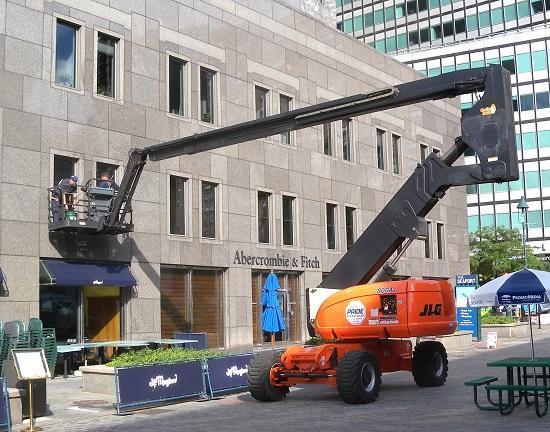Aerial work platforms, also known as boom lifts, scissor lifts, and cherry pickers, are a common sight on construction sites and other workplaces. These machines can be incredibly useful, allowing workers to reach heights that would otherwise be impossible. But as with any piece of equipment, aerial work platforms come with their own set of safety risks.
In this article, we’ll take a closer look at aerial work platform safety and provide 10 tips to keep workers safe while using these machines:
- Understand the machine’s capabilities and limitations. Before using an aerial work platform, it’s important to understand the machine’s capabilities and limitations. This includes its weight capacity, maximum reach, and any other limitations specific to the machine. Understanding these limitations will help ensure that the machine is used safely and that workers do not exceed its capabilities. By knowing the machine’s capabilities and limitations, workers will be able to use the machine safely and efficiently. Additionally, workers will be able to identify when the machine is not suitable for a specific task or when it’s necessary to bring in a different type of equipment.
- Ensure that the machine is in good working condition. Before using an aerial work platform, it’s important to ensure that the machine is in good working condition. This includes checking for any visible damage or wear, ensuring that all safety features are functioning properly, and making sure that the machine has been properly maintained. A machine that’s not in good working condition can be dangerous and put workers at risk. Regularly inspecting and maintaining the machine will ensure that it’s always in good working condition and ready for use. Employers should also ensure that the maintenance of the machine is done by a trained and certified professional.
- Use the machine’s safety features. Aerial work platforms come equipped with a variety of safety features, such as guardrails, toe boards, and outriggers. These features are there to protect workers, so it’s important to use them as intended and make sure they are in good working condition. Using these safety features can help prevent accidents and injuries. It’s also important to make sure that the safety features are in good working condition, as a faulty safety feature can compromise the safety of the worker.
- Wear appropriate personal protective equipment (PPE). When using an aerial work platform, it’s important to wear appropriate PPE, such as a hard hat, safety glasses, and fall protection. This will help protect workers in the event of an accident. PPE can be the difference between a minor injury and a severe one or even a life and death situation. Wearing PPE such as hard hats, safety glasses and fall protection can also help protect workers from falling objects, electrical hazards and other potential hazards. Employers should also ensure that the workers are properly trained on the use and maintenance of PPE.
- Use the machine on a level surface. Aerial work platforms are designed to be used on level surfaces. Using the machine on an uneven or sloped surface can be dangerous, so it’s important to ensure that the machine is on a level surface before use. Operating the machine on an uneven or sloped surface can cause the machine to tip over or become unstable, putting workers at risk. It’s important to make sure that the machine is on a level surface, and that the machine is properly stabilized before use.
- Don’t exceed the machine’s weight capacity. Aerial work platforms have a specific weight capacity, and it’s important to not exceed this capacity. Exceeding the weight capacity can cause the machine to become unstable or tip over, putting workers at risk. Workers should always be aware of the weight capacity of the machine they are operating and ensure that they are not exceeding it.
- Keep the work area clear. When using an aerial work platform, it’s important to keep the work area clear. This includes removing any debris or obstacles that could cause the machine to tip over or become unstable. A cluttered work area can cause accidents and injuries, it’s important to keep the area clear to ensure that the machine can be operated safely.
- Use the machine’s stabilizers. Many aerial work platforms come equipped with stabilizers that help keep the machine stable during use. It’s important to use these stabilizers as intended and make sure they are properly adjusted before using the machine. The stabilizers are designed to help prevent the machine from tipping over or becoming unstable, so it’s important to ensure that they are being used properly.
- Follow proper setup and operation procedures. Each type of aerial work platform has its own unique setup and operation procedures. It’s important to follow these procedures to ensure that the machine is used safely and that workers are not put at risk. Employers should also ensure that the workers are properly trained on the setup and operation procedures of the machine they are using.
- Stay alert and avoid distractions. When using an aerial work platform, it’s important to stay alert and avoid distractions. This includes not using the machine while under the influence of drugs or alcohol, and avoiding any activities that could cause a distraction, such as using a cell phone. Distractions can cause accidents and injuries, it’s important to stay focused
In conclusion, aerial work platforms can be incredibly useful, but they also come with their own set of safety risks. By understanding the machine’s capabilities and limitations, ensuring that the machine is in good working condition, using the machine’s safety features, wearing appropriate PPE, and following proper setup and operation procedures, you can help keep workers safe while using these machines. Remember, safety should always be a top priority when working with aerial work platforms.










